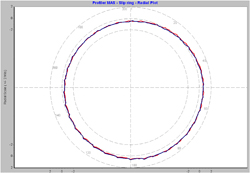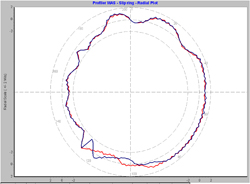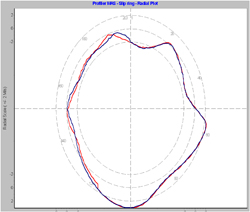Wind Turbine Slip Rings:How round is round?
What does it mean to be round? That becomes an important question when it comes to the power transfer on a wind turbine. The slip ring on a wind turbine generator is a critical part of the excitation system. A good understanding of slip rings will help keep a turbine running more efficiently, for longer, and at a lower cost.
Power is transferred to the slip ring by sliding electrical contact from copper graphite brushes. To efficiently transfer the excitation current, the brushes need to make intimate contact with the slip ring at speeds up to 5,000 feet per minute. On a generator operating at synchronous speed for only 10 hours per day, the brush would still travel more than 150,000 miles on the slip ring in one year. Most of us wish our car tires had a lifetime of 150,000 miles.
The quality of the power transfer is directly connected to the contact between brushes and slip rings. Slip ring roundness is crucial for proper performance. Though this seems like an obvious point, the slip ring needs to be round to ensure the electric brush makes close contact and transfers power properly. Commonly used specifications state that a new slip ring’s Total Indicator Runout (TIR) needs to be under 0.001", and under 0.003" for an in-service slip ring.
All slip rings will begin to wear and should be monitored to ensure the wear is not excessive, or affecting the life or performance of the brushes. Slip rings could last the life of the generator, but other components and complications—such as loss of brush contact, unstable brushes, high vibration, or low spring force—can cause the slip rings to wear. This wear is not always uniform around the slip ring, and uneven wear will cause the slip ring to lose its roundness over time.
A little worse for wear


Figure 1. Round Slip Ring 0.1" TIR | Figure 2. Worn slip ring 0.003" TIR
Figure 1 shows the test profile of a good, round slip ring; whereas, Figure 2 is the test profile of a slip ring that has been in service for three years, and is beginning to wear. This ring was not only worn out of round but, upon closer inspection, it also had a 0.010" groove on the ring surface. The brushes used on the slip ring in Figure 2 are most likely arcing and beginning to wear at an accelerated rate, possibly resulting in a phase-to-phase flashover if the sparking is excessive.

The brushes used on the slip ring depicted in the test profile in Figure 3 are arcing and causing even more damage with every revolution. There are many different types of slip ring wear, including threading, grooving, and burning. Although the causes and the test analyses of various wear types on slip rings are extensive, and could take many articles to adequately cover, the one condition that puzzles most maintenance personnel is footprinting (or ghosting).
Figure 3. Worn slip ring 0.006" TIR
Footprinting
Footprinting is caused by the loss of contact of all the carbon brushes on one slip ring, simultaneously. The loss of brush contact results in arcing that burns an image of the brush into the slip ring. These images will be the same distances apart as the individual brush holders. The footprint image forms as low-level sparking caused by a mechanical disturbance that occurs at the same time during each revolution.
When the footprinting is in the image stage only, there’s no appreciable wear on the slip ring. A typical generator rotates five million times per week, so after many months and hundreds of millions of revolutions, this low-level sparking will have created a rough surface. The image will eventually span around 25% to 50% of the slip ring and begin to damage the surface, limiting the overall brush life. It’s common when footprinting occurs for one-half of the slip ring to be worn and the other half to not show any damage at all.
This loss of brush contact that leads to footprinting could be caused by carbon brush instability, high machine vibration, or low spring force. The carbon brush can be made more stable by using a longer brush holder, adding a rubber hardtop to the brush, or changing the brush design. The issue of high machine vibration needs to be addressed not only for the carbon brushes, but also for other components within the rotating system. Because common life expectation for carbon brush springs is approximately five years, old and slow-responding springs need to be replaced. Most brush holders are designed for easy spring replacement, so replacing springs before they cause damage to the slip ring can save a company thousands of dollars. Springs are a regular, simple maintenance item, just like a filter in a car. Springs need to be in good condition for proper slip ring performance.
Conclusion
It’s amazing that such a small part can hold such power, but proper understanding, testing, and inspection of a turbine’s slip rings will increase the efficiency of the excitation system. When that system’s efficiency and productivity are increased, so will the efficiency and productivity of the entire wind turbine. Unlike the slip rings, the effect on the bottom line will not be small.
Roland Roberge is the manager of design and application engineering for MorganAM&T. He has also held other positions for MorganAM&T, such as operation manager and project engineer.
MorganAM&T is an advanced materials and technology company that has continued to expand in materials science—from carbon to ceramics and polymer composites to metallics. MorganAM&T’s global presence includes 40 operating facilities in 25 countries, with major materials processing plants in the US, the UK, and China.
MorganAM&T
www.morganamt.com
Author: Roland Roberge
Volume: May/June 2012











